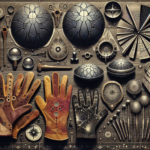<!DOCTYPE html>
<html lang="en">
<head>
<meta charset="UTF-8">
<meta name="viewport" content="width=device-width, initial-scale=1.0">
<title>Resonating Through Generations: Handpan and Traditional Instruments</title>
</head>
<body>
<header>
<h1>Resonating Through Generations: Handpan and Traditional Instruments</h1>
</header>
<article>
<section>
<p>The melodious interplay of musical instruments reflects the diverse cultures and histories across the world. Among these instruments, the handpan stands as a modern emblem of creativity fused with ancient traditions. With its distinctive voice and mesmerizing sounds, the handpan extends a bridge between the past and the present, connecting with traditional instruments from various cultures.</p>
<p>The handpan, classified as an idiophone, might be modern in conception, originating in the early 21st century, but its roots extend deep into the annals of music history. Traditional instruments across the globe resonate similarly and serve as reminders of music's intrinsic role in human expression.</p>
</section>
<section>
<h2>Origins and Development of the Handpan</h2>
<p>The handpan, a relatively new instrument, was born in the year 2000 in Switzerland. Felix Rohner and Sabina Schärer, founders of PANArt, developed the handpan from an exploration of steel percussion. Building upon the design of the Trinidadian steel drum, Rohner and Schärer combined influences from the Ghatam, an Indian percussion instrument, and the Hang, their initial creation.</p>
<p>The handpan resembles a UFO or an inverted steel drum with a central dome and tonal fields arranged in a circle. It's played with the hands, which allows for a gentle, expressive touch. The handpan’s captivating soundscape has drawn interest from musicians of various genres, from classical to electronic, thereby broadening its appeal.</p>
</section>
<section>
<h2>Traditional Instruments and Their Timeless Appeal</h2>
<p>Traditional instruments from cultures around the world also bring their unique sounds and histories to the musical fabric of society. Each instrument carries centuries of cultural significance, connecting communities across generations. Let's explore a few of these instruments and their contributions.</p>
<h3>1. African Djembe</h3>
<p>The djembe, a West African drum, is known for its wide range of pitches and distinctive timbre. Historically, it is used in healing, storytelling, and ceremonial gatherings. The djembe's communal aspect and powerful rhythms bring people together, facilitating communication and unity.</p>
<h3>2. Indian Sitar</h3>
<p>The sitar, iconic in Indian classical music, has a resonating sound that embodies the expressive and spiritual qualities of the music it creates. It features a long neck with movable frets and multiple strings, producing intricate melodies. The sitar has significantly influenced Western musicians and bands, enriching the global music landscape.</p>
<h3>3. Scottish Bagpipes</h3>
<p>Bagpipes have become synonymous with Scottish culture, producing a sound that is both haunting and celebratory. Historically, bagpipes were used in warfare to inspire troops, as well as in social and festive occasions. Its distinctive droning harmonics offer a sense of nostalgia and pride for those connected with its heritage.</p>
<h3>4. Chinese Guzheng</h3>
<p>The guzheng, part of the Chinese zither family, boasts a rich history over two millennia. It is revered for its elegant sound, characterized by plucked strings that create cascading pitches. The guzheng remains an integral part of both traditional Chinese music ensembles and contemporary experimental performances.</p>
</section>
<section>
<h2>Handpan and Traditional Instruments: A Harmonious Blend</h2>
<p>The handpan’s versatility allows it to blend beautifully with traditional instruments, creating soundscapes that are at once historic and avant-garde. Musicians who strive to innovate are pairing the handpan with instruments like the djembe, sitar, bagpipes, and guzheng to explore new dimensions in music.</p>
<p>Incorporating the handpan with the vibrant energy of the djembe can invigorate rhythm sections, adding depth and texture to percussion-heavy compositions. Similarly, the sitar's melodic interchange with the handpan produces ethereal harmonies that evoke tranquility and contemplation.</p>
<p>When combined with the sturdy drone of the bagpipes, the handpan can temper the sound, weaving in lyrical phrases that add whimsical layers to traditional Scottish tunes. Meanwhile, the melodious interplay with the guzheng can introduce new storytelling elements, blending eastern and western musical traditions.</p>
</section>
<section>
<h2>The Role of Technology and Innovation</h2>
<p>Technology plays a pivotal role in bridging the gap between the handpan and traditional instruments. With the advent of digital recording and mixing technologies, musicians can now harness the endless possibilities of sound experimentation. Programs that allow for sound sampling, loop creation, and digital editing enable artists to explore and blend different musical elements with precision.</p>
<p>Digital platforms facilitate global collaborations, allowing musicians to transcend geographical boundaries and share their work with a wider audience. Musicians are able to study the subtleties of different instruments online, further enriching their understanding and composition skills.</p>
<p>Furthermore, innovations in instrument design have enhanced the durability and range of both handpans and traditional instruments, offering new tonal possibilities and dynamic expressions.</p>
</section>
<section>
<h2>Conclusion</h2>
<p>The handpan's rise as a sought-after instrument exemplifies the seamless blend of modern innovation and cultural tradition. Together with traditional instruments, the handpan forms a fascinating narrative that resonates through time and across cultures. The music created at this intersection is a testament to the evolving nature of art—shapeshifting yet timeless, bound by a shared human experience.</p>
<p>As more musicians discover and experiment with the melodic synergies between handpans and traditional instruments, they foster an appreciation for both innovation and heritage. This acoustical tapestry enriches the global music landscape, nurturing a longing for unity and connection through the universal language of music.</p>
</section>
<section>
<h2>Frequently Asked Questions (FAQs)</h2>
<h3>1. What makes the handpan unique compared to other percussion instruments?</h3>
<p>The handpan is unique due to its melodic nature, allowing players to produce both rhythm and tune with just their hands. Its distinct sound and resonance set it apart from many other percussion instruments, providing a meditative and calming auditory experience.</p>
<h3>2. How difficult is it to learn to play the handpan?</h3>
<p>While the handpan does not require prior musical knowledge, developing complex patterns and musical expression can take time and practice. Many players find the learning process intuitive, especially since it primarily uses hand coordination and striking techniques.</p>
<h3>3. Can handpans be used in orchestral settings?</h3>
<p>Yes, handpans can be incorporated into orchestral arrangements. Their versatility allows them to blend with both string and wind instruments, adding unique layers and textures to the orchestral sound.</p>
<h3>4. What are some notable collaborations involving the handpan and traditional instruments?</h3>
<p>There have been numerous collaborations worldwide, where musicians blend the handpan’s sound with instruments like the Indian tabla, didgeridoo, and even the Middle Eastern oud, showcasing diverse cultural fusions and innovative compositions.</p>
<h3>5. Are traditional instruments losing their significance to modern innovations?</h3>
<p>While modern instruments like the handpan gain popularity, traditional instruments retain their cultural and historical significance. The blending of both worlds often leads to modern appreciation for traditional music, inspiring a deeper understanding and respect for cultural heritage.</p>
</section>
</article>
</body>
</html>Resonating Through Generations: Handpan and Traditional Instruments

Leave a comment




